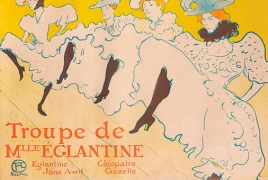Major Henri de Toulouse-Lautrec exhibit on view at AMO-Palazzo Forti July 27, 2017 - 18:40 AMT PanARMENIAN.Net - Paris, end of the 19th century; la vie bohémienne, the artists of Montmartre, the Moulin Rouge, the brothels, the theatres and the prostitutes. This was the life Henri de Toulouse-Lautrec (1864–1901) led and depicted, becoming its most famous exponent, Art Daily said. Toulouse-Lautrec was only 4 feet 8 inches tall – he had a form of dwarfism – and died at the age of 36 from the ravages of syphilis and alcoholism, but he became famous, above all, for his advertising posters and portraits of personalities of the day. His images of the dancers at the Moulin Rouge, Aristide Bruant and the scantily-clad prostitutes in the maisons closes, where he had his atelier, are fixed in the collective imagination. This major exhibition is on view until 3 September at AMO-Palazzo Forti celebrates Toulouse-Lautrec's artistic trajectory with 170 works from the Herakleidon Museum in Athens. Posters, lithographs, drawings, illustrations, watercolours, as well as videos, and photographs and furnishings of the period take the visitor back in time by reconstructing life in bohemian Paris. The most famous works on display include coloured lithographs like Jane Avril, 1893, advertising posters like The Passenger in Cabin 54,1895, and Aristide Bruant in his Cabaret,1893, pencil and pen and ink drawings, promotional graphics and magazine illustrations as in La Revue Blanche,1895, that have become the emblem of an era inextricably connected with the images of Count Henri de Toulouse-Lautrec. The exhibition is divided into 10 thematic sections corresponding to the major historical, technological, social and architectural changes taking place in Paris at the end of the 19th century, the glittering belle époque. The first four sections are devoted to the Parisian Nights: the three rooms named after individual protagonists of the night life are followed by a fourth room devoted to the world of entertainment from the Moulin Rouge to the Opéra. One of the best-known aspects of Toulouse-Lautrec's oeuvre is the posters he made for night clubs. He had the novel idea of focusing on the artists who performed there as an advertising ploy and brilliantly captured the different types and characters. Indeed, he was really and truly the inventor of the star system! He struck up a firm friendship with the French singer-songwriter and cabaret artist Aristide Bruant (1851–1925), and contributed to defining this personality through a series of prints and lithographs. These included Aristide Bruant, in his Cabaret (1893), where he is depicted wearing his flowing cape, broad-brimmed hat and red scarf. The modern impact these stylized works make, through their solid colours, brought him immediate and unexpected fame. The figure of Yvette Guilbert (1868– 1944), nicknamed La Diseuse is unforgettable – on stage her signature was a pair of elbow-length black gloves. Fascinated by the personality of this actress and singer, Toulouse-Lautrec devoted a whole album of lithographs to her – Album Yvette Guilbert, 1894, on display in the exhibition – as well as various drawings and engravings. Toulouse-Lautrec also established a friendship with the famous cabaret star Jane Avril (1868–1943), who was wild and irresistible on stage. He depicts her as a cultured sophisticated lady at a café chantant in the poster Divan Japonais (1893), but also dancing the can-can with other dancers in Mademoiselle Eglantine's Troupe (1896). Finally, a large room is devoted to the varied world of entertainment, from popular cabaret scenes to more serious Greek tragedies and concerts at the Opéra. Toulouse-Lautrec would say "It doesn't matter what the show is. I'm always happy at the theatre!" indeed, these works are always fascinating and express joy and pleasure. In his theatrical scenes Toulouse-Lautrec consummately renders the intensity of the dramas and comedies with striking movements and strong contrasts of light and shade, which are inspired by Japanese woodcuts and Honoré Daumier's theatre boxes. The works on display include the series of witty lithographs made in 1893 for the collection Le café-concert. Photo: Herakleidon Museum, Athens Greece Ara Aivazian said Azerbaijan continues the traditions of Turkey after seizing territories and forced Armenians out. The creative crew of the Public TV had chosen 13-year-old Malena as a participant of this year's contest. She called on others to also suspend their accounts over the companies’ failure to tackle hate speech. Penderecki was known for his film scores, including for William Friedkin’s “The Exorcist”, Stanley Kubrick’s “The Shining”. Partner news |